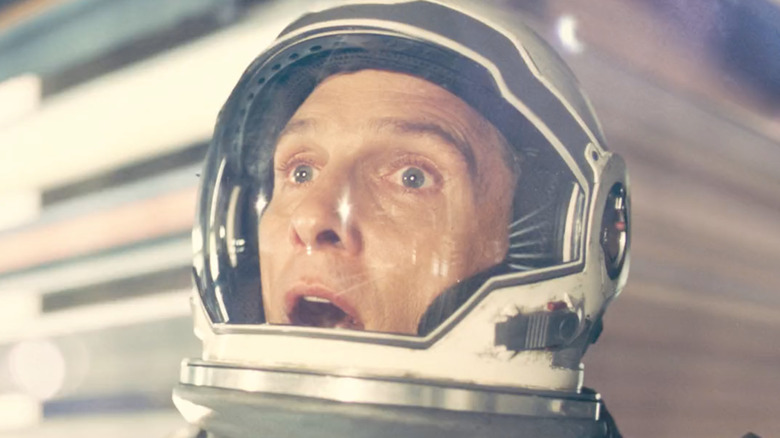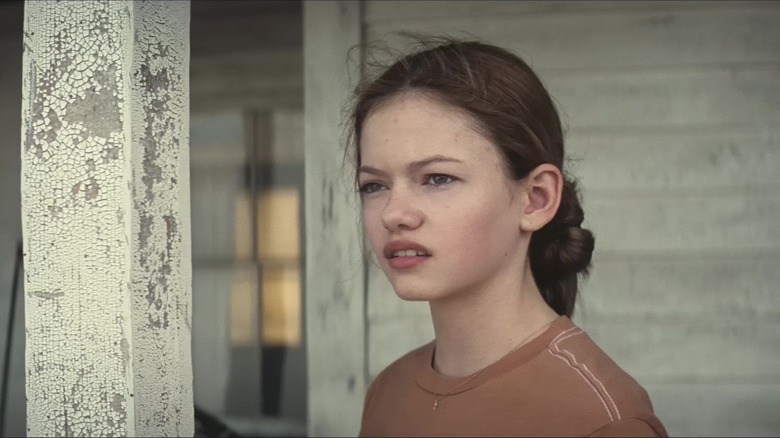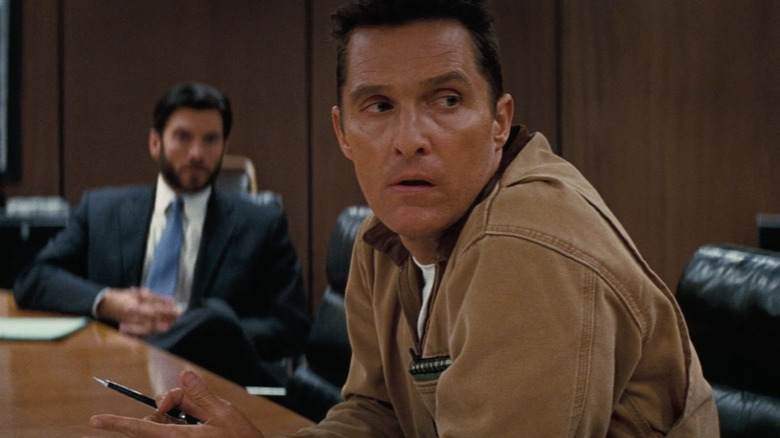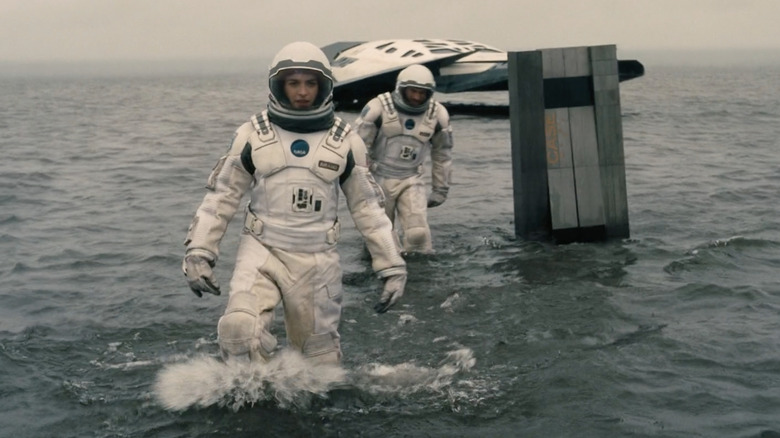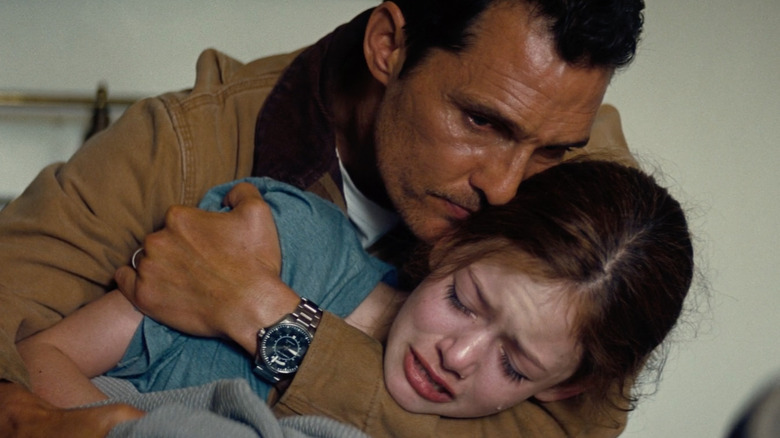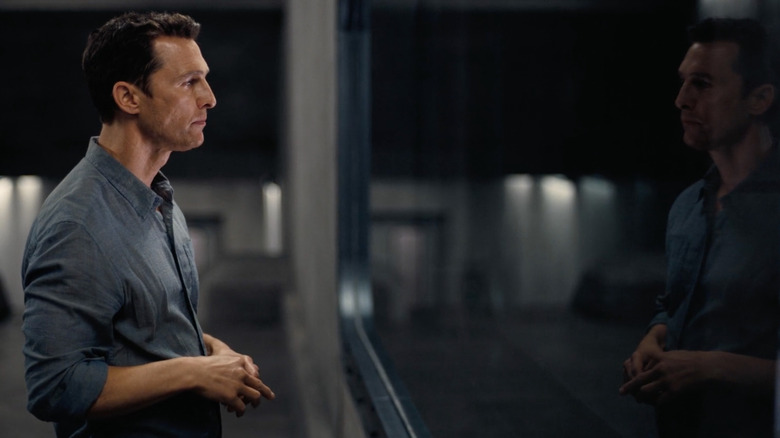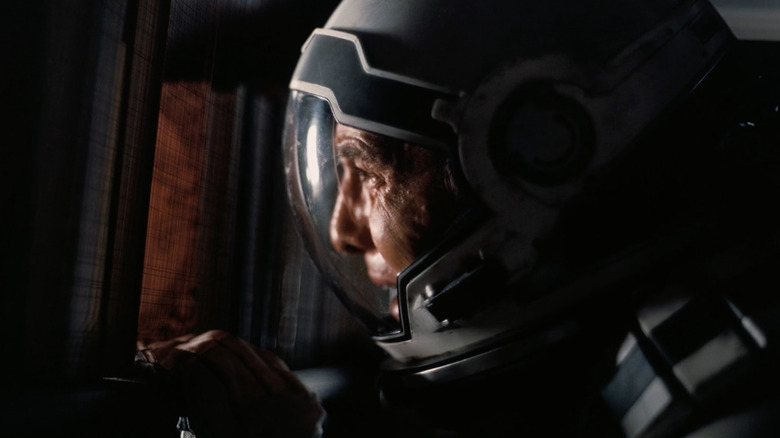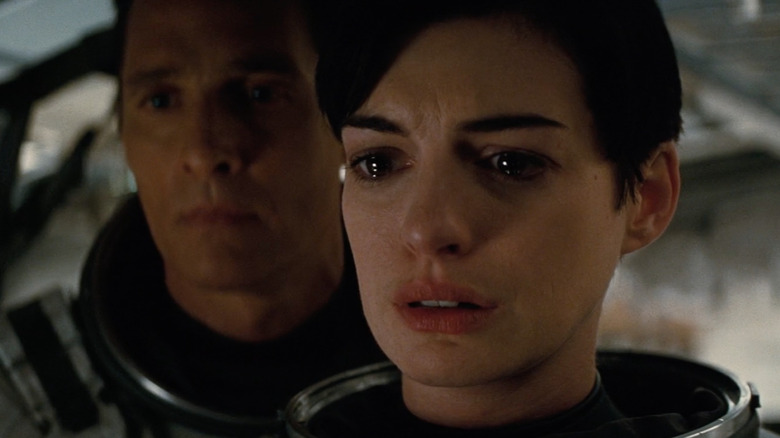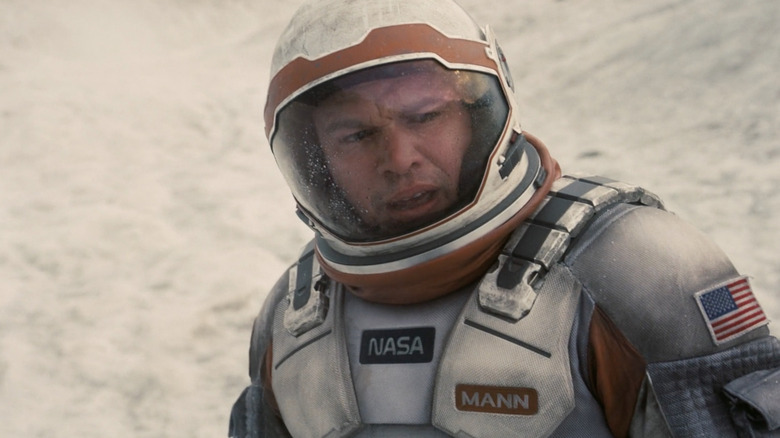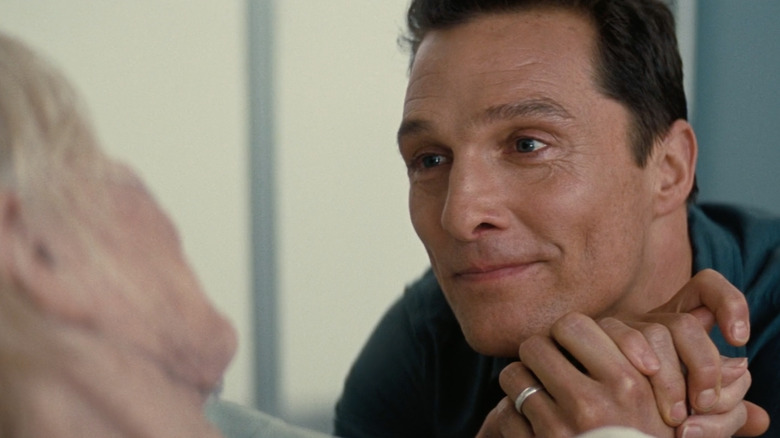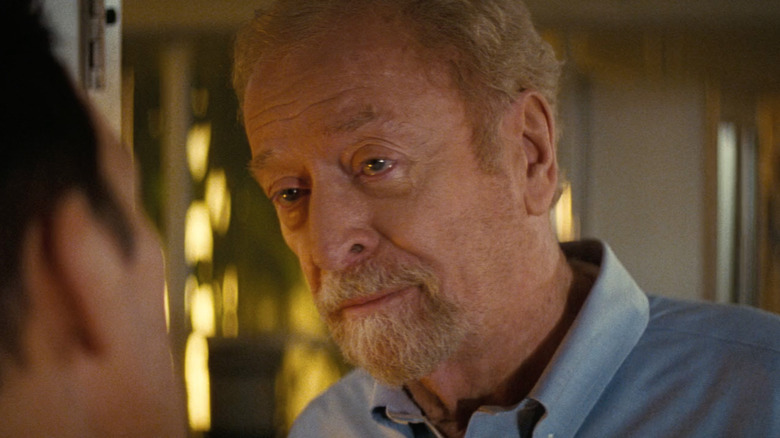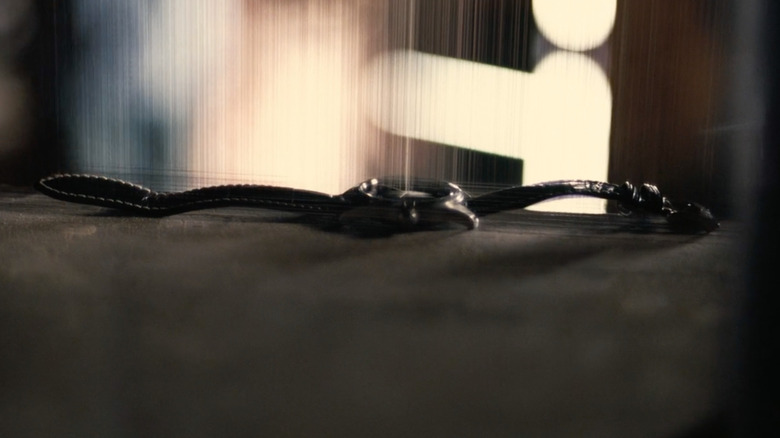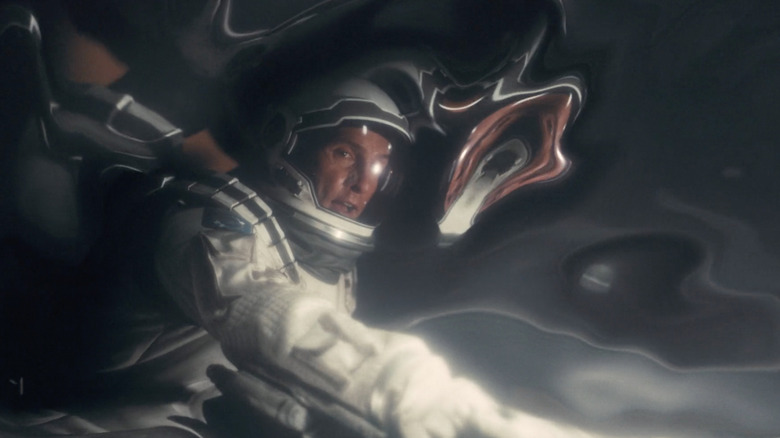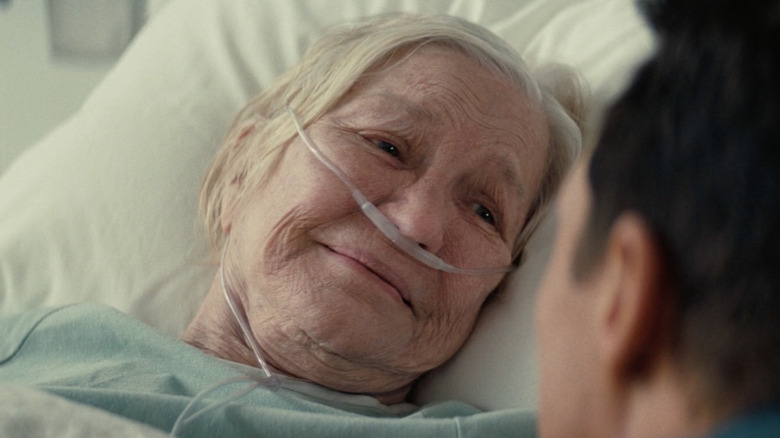Things You Only Notice In Interstellar After Watching It More Than Once
A cosmic, decades-spanning narrative traversing millions of lightyears is a legendary feat only a few cinema titans are capable of. At the top of that short list is director Christopher Nolan, who delivered the goods with 2014's Interstellar. It tells the story of Cooper (Matthew McConaughey) and his journey to a distant, uncharted galaxy to save our doomed planet. Interstellar is a visual spectacle grounded in a scientific (albeit, theoretical) reality and wrapped in an emotional tale of primal human connection.
The dynamic between Cooper and his daughter, Murphy (Jessica Chastain), is the core relationship propelling Interstellar forward to its mind-bending climax. These emotional moments give a pulse to a mesmerizing universe. The combination of heart-wrenching conflict and ocular delight is a potent mix. Along with this emotional core, Nolan injects paradoxical and ambiguous elements into the film, leaving the audience to interpret the experience as they see fit. It is an attribute that demands multiple viewings of Interstellar. Revisiting Cooper's journey into the stars is highly recommended, because there are things you only notice in Interstellar after watching it more than once.
Spoilers ahead if this is your first voyage.
Murphy's opening dialogue hints at Cooper's fate
The convergence point for the entire decades-spanning story in Interstellar is Murphy's childhood bedroom. There is a poltergeist chucking books off her bookshelf and toying with the physics of gravity and magnetism. Ten-year-old Murphy (played by Mackenzie Foy) doesn't appear to be afraid of the apparition, just mostly curious. Luckily, she is being raised by a father with a scientific mind who doesn't succumb to superstition. Cooper instructs her to not just label it as a "ghost" because she doesn't know what it is, but to study it and come to a scientific conclusion. Murphy's instincts end up being accurate all along and her first line of dialogue in Interstellar hints at the final outcome.
The opening moments of Interstellar feature a brief tumultuous moment from Cooper's days as a pilot. His aircraft spins out of control and the Gs amp up before he suddenly snaps awake, safely at home in his bed. Standing over him is Murphy, who looks at him and says, "I thought you were the ghost." Ultimately, by the end of the film, we find out just how accurate she was with this statement.
Cooper would not have found NASA had he not already been there
Christopher Nolan is fascinated with the intricacies of time. The paradoxes created by toying with timelines are of particular interest to him. Interstellar creates scenarios where time stretches and squeezes based on the galactic location of the characters. Events are unknowingly triggered by the characters themselves, leading them to the NASA base where Cooper signs on to pilot a mission to save the world. Coordinates to this base are received from the "ghost" in Murphy's room. The directions are given in binary by altering gravity, so billowing dust settles strategically on the floor to spell out a message. The ghost ends up being Cooper himself, from inside the tesseract within the massive black hole known as Gargantua. But where did this whole chain of events begin?
As we find out later in Interstellar, the instructions on how to find the NASA base were given to Cooper by...Cooper. However, in order to get inside the tesseract and give himself those directions, he needed to have already received those directions. It creates a paradox to which there is no answer. The notion of an unanswerable question is a quality that screams Christopher Nolan. The director must derive joy out of making our brains cramp up.
The strange ticking sound on the water planet
Once the crew of the Endurance travels through the wormhole into an unknown galaxy, they receive a clearer picture from the data sent out by previous explorers on all the possible planets orbiting Gargantua. After deliberation, they decide to first visit a planet closer to the black hole. Its proximity to the massive gravity created by Gargantua creates problems with relativity. Time on this planet runs much slower than on Earth (every hour here is worth seven years back home) and therefore must be considered a resource, one they do not have in abundance. The whole excursion is incredibly stressful and with more viewings of Interstellar it's only amplified. Especially once you notice the strange ticking sound playing in the background the entire time they are on this first planet.
Turns out there is a reason this ominous ticking plays consistently throughout the scene. Cinema sleuths discovered these ticks occur exactly 1.25 seconds apart. With a little math it was revealed that each tick counts for an entire day passing on Earth. This knowledge adds a layer of stress to an already tense experience on the water planet. Multiple viewings of Interstellar only peel back more layers to this odyssey.
The ghost of our children's future
The most exciting part of any space adventure obviously occurs once the characters are out voyaging among the stars. This quality leaves us feeling antsy in our first viewing of Interstellar. We are anxious to hop into a rocket ship and launch into space, but that causes many of the most fascinating elements of the story to slip by unnoticed. Every bit of dialogue in Interstellar has a purpose because everything comes full circle. Cooper's talk with Murphy is a particularly prophetic conversation that hits harder with more views.
"Once you're a parent, you are the ghost of your children's future," Cooper states to Murphy before he leaves Earth. The poetic message winds up becoming reality in more ways than one. Not only does Cooper quite literally end up being the "ghost" in her bedroom but he also, in a way, becomes a figurative ghost walking into the hospital room where Murphy is on her deathbed. He is the same age as when he left Earth. Cooper is stepping back into her life exactly as he was in her memories — a ghost in her future.
You never find out Cooper's first name
Matthew McConaughey's character has a background as a pilot in what we assume is the military. All the armies on Earth became obsolete though, because we had bigger things to worry about (like food). This left him with a niche skill with no application, so he turned to farming. One thing that remained from his past, however, is being referred to by his last name: Cooper. Everyone in Interstellar refers to him as Cooper and you don't realize it's not his first name in the initial viewing.
We actually never find out Cooper's first name. He connects with his surname so much that he mistakenly assumes in the future that "Cooper Space Station" is named after himself, before learning it was actually named after his daughter, Murphy Cooper. Chances are the man's name is not Cooper Cooper. Weirder things have occurred in this reality, but it is still more improbable than surviving the dreaded spaghettification inside a black hole singularity.
Don't let me leave!
There are multiple heart-wrenching moments in Interstellar, the most memorable being the soul-crushing moment when Cooper and Brand realize they have lost 23 years of time on Earth because of their snafu on the first planet. The cost of the failed endeavor is Cooper having to sit through a rapid fire round of videos watching his children grow up without him. With more than one viewing of Interstellar another moment will hit equally hard: when Cooper is trapped in the tesseract watching himself leave Murphy again and again.
Even more haunting is how much Cooper's pleas echo through time. At one specific moment, Cooper is pleading with his angry daughter while he is trying to say goodbye. He begs her, "Murph, please don't let me leave like this." The stubborn girl refuses to acknowledge him, a decision that haunts her in the future. Equally devastating is the reality behind the grander picture. While one version of Cooper is pleading in person with his daughter, another version of him is trapped inside the tesseract screaming the same sentiment into the ether, "Don't let me leave, Murph!" We don't know how many more tears we can hold back with this story.
No family attachments?
The small crew of the Endurance is not the first group of brave astronauts to plunge themselves into the wormhole near Saturn. A decade before this mission departed, a group of 12 was sent across the universe to explore the viability of these new worlds. Each individual was sent to their own planet to discover the possibilities. Due to the potential of a suicide mission for these astronauts, Brand (Anne Hathaway) explained that they were required to not have any attachments on Earth. While this was a strict prerequisite, it was apparently not so inflexible for the follow-up mission.
Among the Endurance crew, half of them have family attachments. Cooper has two kids he desperately wants to return home to, while Brand is the daughter of the lead scientist. The "no attachments" stipulation of the first mission was based on the logic that people would operate with the whole human race in mind as opposed to individual desires. We're surprised this crucial second mission lacked the same stern guidelines.
Mann's survival instincts
When Matt Damon's Dr. Mann sits up in his cryotube, it is a pleasant surprise that the filmmakers kept secret before Interstellar hit theaters. We can see why too. It's distracting for a few minutes. Knowing he was in the film would have had us wondering where Matt Damon was for the first half of Interstellar. We usually see the actor in heroic roles and in this case the opposite was true: he's not a villain per se, but more of a cowardly antagonist.
Mann's survival instinct is an important contrasting element to the story. Interstellar, at its core, is a tale of human connection. Since the first crew sent into the wormhole were required to not have any attachments, Mann doesn't share the same deep connections that Brand and Cooper have. This leaves him purely self-serving. He attempts to mask this, but everything he does feels illogical. He's a man operating purely on fear. Mission leaders believed that no attachments would help the crew work with the greater good in mind, but the opposite ends up being true. The only people to survive either mission are those with connections back on Earth.
Over 80 years for a quick hello
When Cooper is trying to console his daughter before his trip, he attempts to appeal to her intellectual sensibilities by discussing the fascinating aspects of time relativity. "When I get back, we could even be the same age," he tells Murphy. The plan backfires when Cooper's daughter realizes that he has no idea when he would be returning from his voyage. Murphy is so upset by this that she doesn't even send a reply message into space for over two decades. The resulting age difference is a reality, but Cooper is off on the numbers by about 60 years or so.
Cooper finally makes it back to his daughter but only in time to witness the final moments of her life. Folks on the Cooper Space Station inform him that he is 124 Earth years old when he returns. Which means he has been gone for over 80 years — a long time for a reunion with his daughter. The large chunk of time lost between the two makes the extremely brief interaction a bit anti-climactic. The final moments of Interstellar start to feel rushed with more viewings.
You can tell Dr. Brand is lying about plan A & B
It's no secret Christopher Nolan is a big fan of Sir Michael Caine. The two have worked together a total of seven times as of this writing. In Interstellar, Caine plays the lead scientist at NASA, Dr. Brand. His sage-like demeanor helps convince Cooper to embark on his voyage and a poetic voiceover from the prolific actor sets a majestic tone as the crew of the Endurance leaves Earth. Knowing the final outcome of this space odyssey will only garner more respect for Caine with each viewing.
It turns out that Dr. Brand never had any intention for the successful execution of "Plan A," which involved humans leaving Earth for a new planet. His formula for harnessing the power of gravity requires a glimpse at data from a singularity inside a black hole; a requirement he saw as impossible. This means all the conversations convincing Cooper to join this mission were laced with a monstrous lie. Knowing this while watching Interstellar more than once will make the nuance of Caine's performance more obvious. You can tell in many of the scenes that he is dodging questions and grows distant when certain topics are brought up.
They relayed complex quantum data via morse code
The main plot twist in Interstellar occurs when it is revealed that Dr. Brand knew he could not complete his gravity equation. The reason is because you needed information from inside a black hole — a task that was deemed impossible due to an inability to see beyond the event horizon and glimpse the singularity within. Luckily for all of humanity, Cooper is willing to sacrifice himself by climbing into a spacecraft and launching himself into Gargantua. Once inside, along with his robot companion TARS, he is able to gather enough data to complete the equation. The trouble is how to get the information back out.
Since Cooper is trapped behind an endless stream of bookshelves in Murphy's bedroom, the only solution is to send this information to his daughter. By manipulating gravity from within the tesseract, Cooper is able to relay the data through Morse code. We know there is a solid amount of theoretical liberties taken with Interstellar, but this one sticks out more with each viewing. We are not going to pretend to be math experts. However, we feel safe in assuming complex quantum data about the occurrences inside a black hole is something not so easily transmitted by a medium as simple as Morse code.
Cooper's luck is astronomically insane
When it comes to cinema, we are perfectly content with suspending some disbelief in order to enjoy the experience. Allowing imagination to take the steering wheel is at the heart of science fiction. Interstellar pushes our hero's luck to the absolute limits though. There is no denying much of Cooper's survival is due to his skills as a pilot, but an insane amount of it is thanks to astronomically small probabilities.
The entire experience of plunging himself into Gargantua requires accepting some liberties regarding the laws of physics. But all the debris coming off his ship as he flies deeper into the vortex makes us question how he survived once he ejected. Also, don't forget Cooper passes through a wormhole without a ship as well. Once on the other side of that wormhole, he happens to be discovered near Saturn, floating in the vastness of space — a highly improbable circumstance for anyone with an understanding of how massive our universe is. The amount of luck involved with Cooper's survival is mind-blowing.
How did Murphy know about Brand?
Cooper's journey dwarfs any distance traveled by any human in history in order to return to his daughter. Unfortunately, because of relativity he returns to find Murphy on her deathbed. The nurse at the hospital informs Cooper she has been in cryosleep for two years. The large amount of family gathered around her suggests that she has lived a full life without him. Murphy states that no one should have to watch their own child die, so she spurs Cooper onward, back into the cosmos, in search of Brand. But how does she know Brand is still alive?
"Brand. She's out there. Setting up camp. Alone...in a strange galaxy," an elderly Murphy's voice says over a montage of Anne Hathaway's Brand settling into her new home planet. It is meant to wrap up the entire film and drive home the idea of moving forward in our lives, but we were left wondering how the filmmakers could trip at the finish line. It is a plot hole that could have easily been remedied by a single line about a debrief. Interstellar's story covers over 80 Earth years, a wormhole, a black hole, and countless light-years... given the circumstances, we can find it in our hearts to move past some omitted information. It's what Cooper would do.
